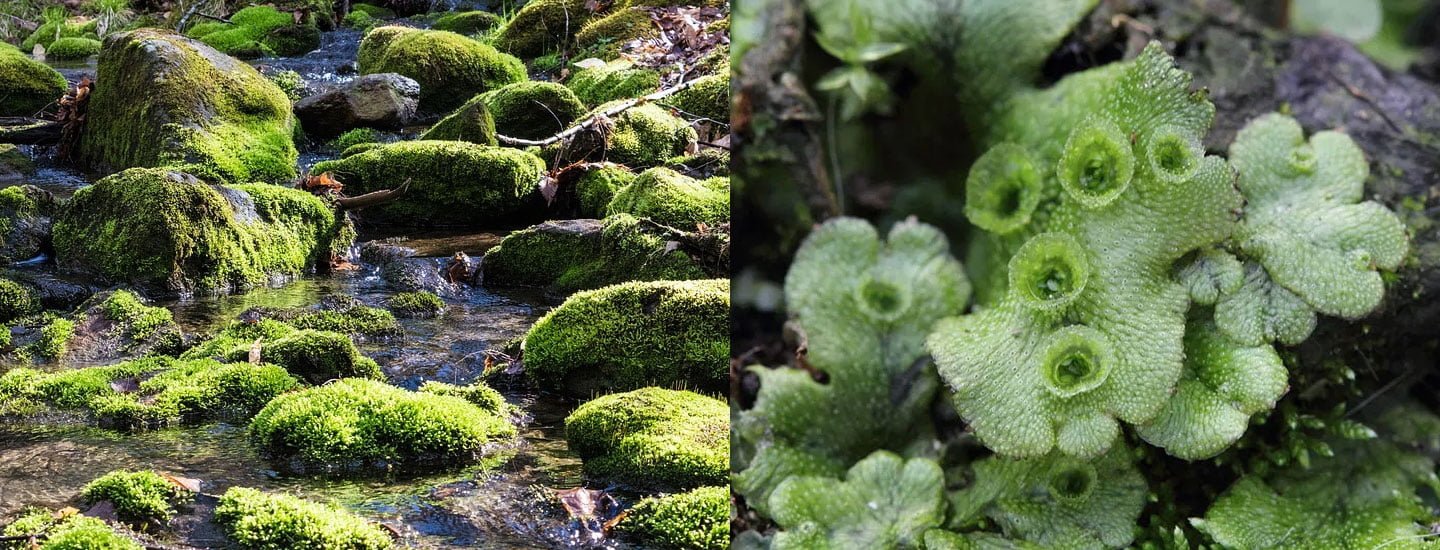To understand Mosses and Liverworts, we first have to know about vascular and nonvascular plants.
Vascular and nonvascular plants:
Before we talk about liverworts and mosses, let’s refresh once vascular and nonvascular plants. Vascular plants are those plants that have vascular tissue which is utilised for the distribution of resources through the plant. This vascular tissue can be divided into two categories, i.e. lignified tissues (the xylem) and non-lignified tissues (the phloem).
- Xylem is used for conducting minerals and water through the plant, whereas phloem is used for photosynthesis. Because of these characteristics, vascular plants evolved into larger sizes.
- On the other hand, non-vascular plants are those plants that lack vascular systems, i.e., xylem and phloem.
- Non-vascular plants cannot become tall compared to vascular plants since they lack the xylem used for the conduction of water and minerals through the plants.
Non-vascular plants division:
Non-vascular plants can be divided into two groups:
- Bryophytes
- Algae
Bryophytes bring us to the topic as. Further, they can be studied into three different groups as shown below:
- Mosses (Bryophyta)
- Liverworts (Marchantiophyta)
- Hornworts (Anthocerotophyta)
As mentioned above, non-vascular plants cannot become tall as they lack vascular tissues; these bryophytes are thus limited in size and generally prefer moist habitats. When we talk about the “life cycle”, bryophytes also have a life cycle with alternation of generation similar to all land plants. The life cycle of land plants has two phases:
- Haploid gametophyte phase
- Diploid sporophyte phase
A single copy of each chromosome is present in the haploid gametophyte phase compared to the diploid sporophyte phase. Two homologous copies of each chromosome are present, usually one from the male and one from the female.
In the case of Bryophytes, the haploid gametophyte phase is the dominant phase, i.e., typical bryophytes remain in the gametophyte phase for a longer duration and enter into the diploid sporophyte for a shorter period.
However, the development of sporophytes occurs differently in the three groups, i.e. mosses, liverworts and hornworts.
Mosses and Liverwort
Let us distinguish between Mosses and Liverwort in more detail now:
Mosses
These non-vascular plants are present as dense green mats, mostly in moist/damp locations. Their leaves are simple in structure which is generally one cell thick and is attached to a stem that can be branched or unbranched. They utilise their leaves to absorb water and nutrients and utilise sunlight and carbon dioxide to carry out photosynthesis.
They lack proper roots. They have a diploid sporophyte phase which means they reproduce using spores and have no flowers. Instead, they have thread-like rhizoids, which are multicellular and help in anchorage.
Their spore-bearing capsules are borne on unbranched stems, and these capsules enlarge and mature after their stalk elongates. These spores germinate to form protonema, which is a thread-like filamentous structure. It is the first stage of development in the haploid gametophyte phase.
Liverworts
These non-vascular plants are distributed globally in every habitat but are present most often in humid locations. Liverworts species can grow as leafless or with leaf. Leafless species grow as the flattened thallus, whereas leafy species have a similar appearance like mosses except for single-celled rhizoids, and their leaves, in most cases, do not have costa but may have cilia.
They have a diploid sporophyte phase which means they reproduce using spores and have no flowers. The immature sporophyte post fertilisation develops into three distinct regions:
- Foot: Which anchors the sporophyte and supplies the nutrient from the “mother” plant.
- Capsule: Which can be spherical or ellipsoidal and have spores inside them.
- Seta: Stalk which lies between foot and capsule and connects them
When all three stages are developed, seta elongates and forces the capsule out. Within the capsule, cells produce both spores and elaters, which scatter themselves when the capsule bursts. Liverwort can reproduce by asexual or vegetative method too, e.g. Marchantia polymorpha, Riccia etc.
Difference between Mosses and Liverworts:
Based on the above information; let us differentiate between liverworts and mosses as mentioned below:
| Characteristics | Liverwort | Mosses |
| Division | Liverwort belongs to the Marchantiophyta division | Mosses belong to the Bryophyta division |
| Description | Liverwort species can grow as leafless or with leaf. Liverwort can exist as thalloid or foliose. | Mosses species have a simple leaf-like structure that is attached to the stem. These stems can be branched or unbranched. Mosses exist as folilose. |
| Rhizoid | The rhizoids of liverworts are unicellular and help in anchorage with the substrate. | Mosses rhizoids are multicellular and help in anchorage. |
| Elater | They are present in liverwort. | Elater cells are absent in mosses. |
| Sporophyte | Liverwort sporophytes can be differentiated into foot, capsule and seta (stalk). | Mosses sporophyte cannot be differentiated into foot, capsule and seta (stalk) |
| Midrib | Liverwort do not have prominent midrib as compared to mosses | Mosses have prominent midrib (costa) |
| Cilia | It is a prominent feature of liverworts | They have marginal cilia like structure as compared to liverworts |
| Protonema | Protonema is absent in liverworts. | Protonema is present in mosses which eventually develop into gametophore, i.e. adult form of a gametophyte. |
| Stomata | Liverworts lack stomata which are required for gaseous exchange | Mosses have stomata present in them in the sporophyte phase, which facilitates gaseous exchange. |
| Example | Marchantia polymorpha, Riccia | Bryopsida, Andreaeobryopsida |
Similarities between mosses and liverworts:
Based on the above discussion, we can now conclude the significant differences between liverwort and mosses. But that does not make them entirely different from each other as they share many similarities too, as mentioned below:
- Both live in wet/humid conditions and have a life cycle that consists of both gametophytes and sporophytes.
- Both have a dominant gametophyte phase compared to the sporophyte phase, which is partially dependent on the gametophyte phase for nutrients.
- Although both possess rhizoids, which are unicellular in liverwort and multicellular in mosses, they perform the same function, i.e. they facilitate anchorage with the substrate.
- Since they are non-vascular plants, both of them are non-flowering and lack true stems, roots and leaves.
Conclusion:
Mosses and liverworts have similarities and simultaneously have distinct features, which makes them different from each other.







